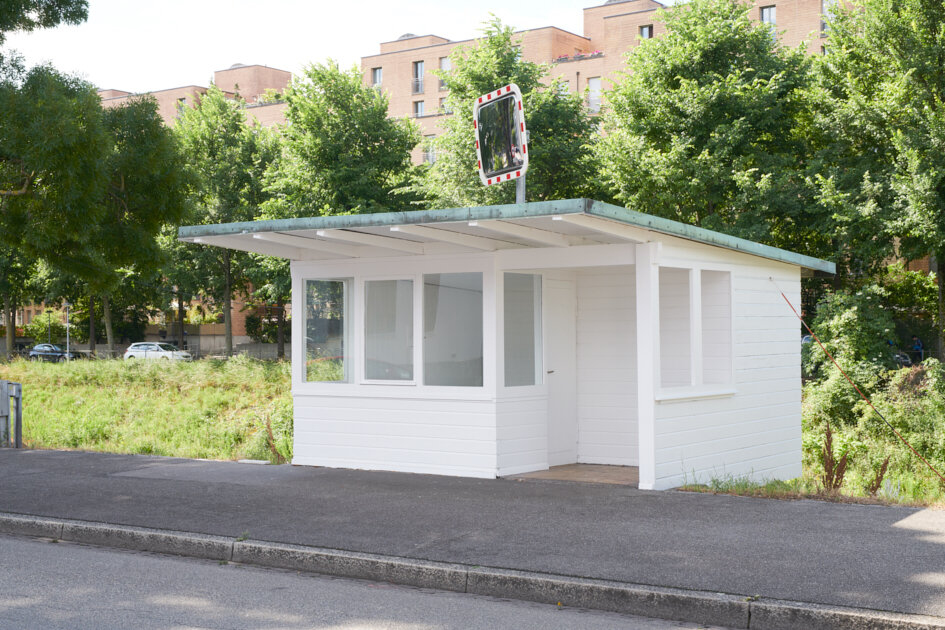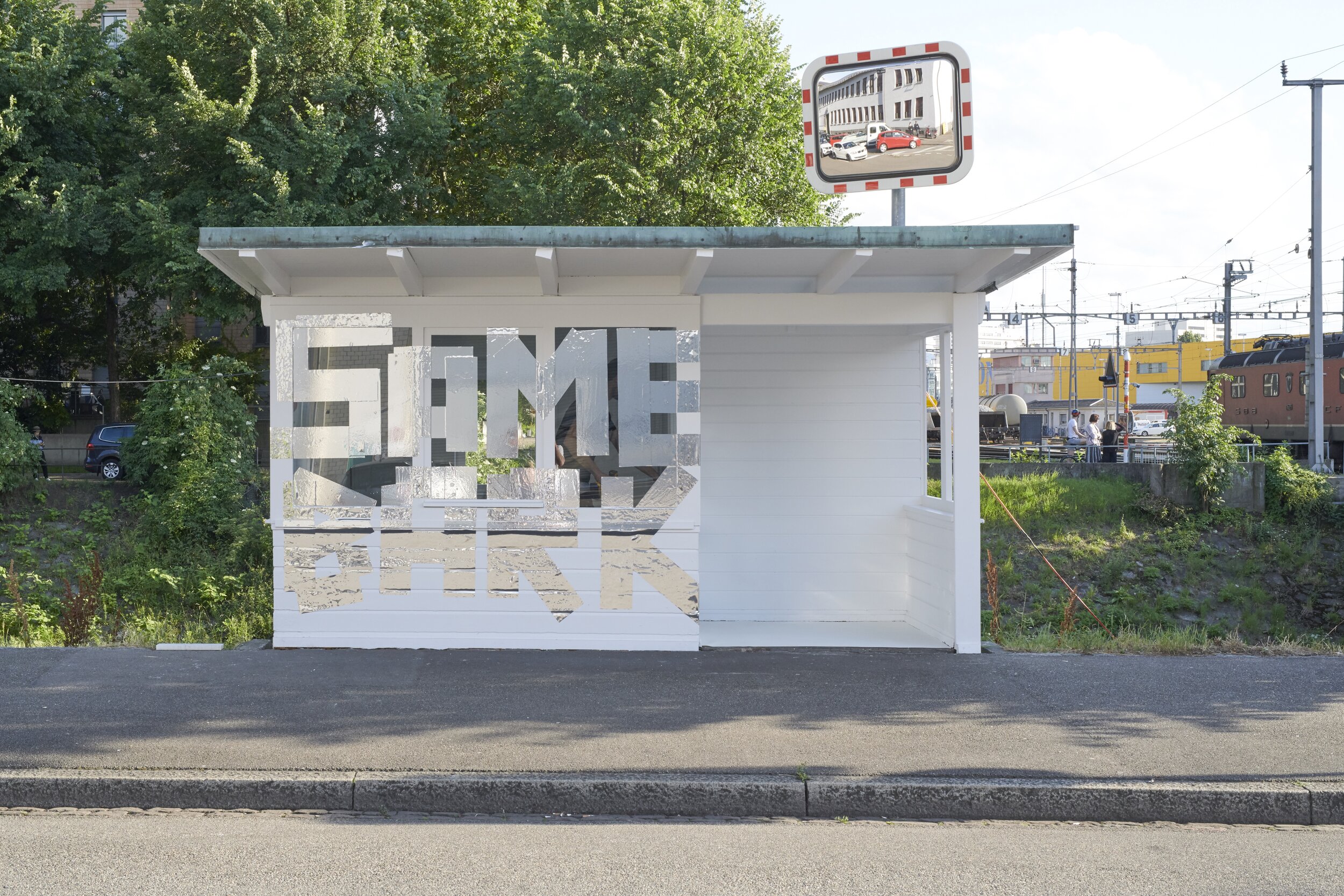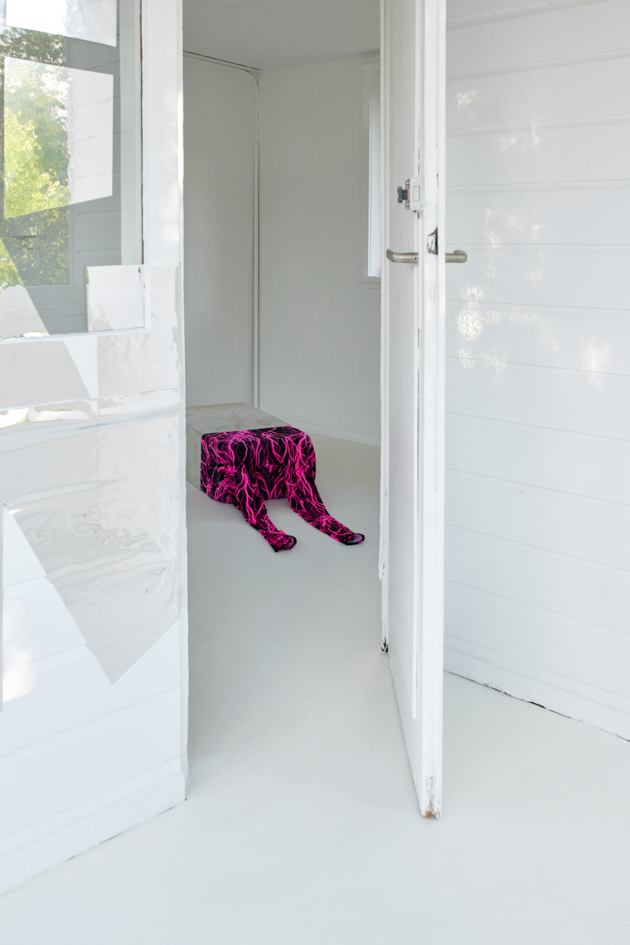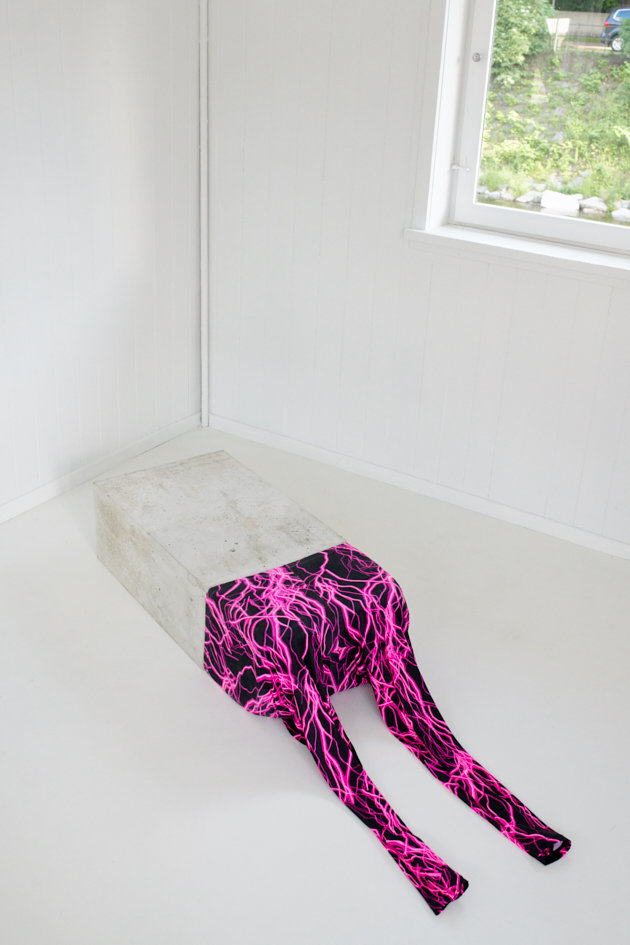12.06.19 – 21.08.19
Pawel Ferus
pretty close –
pretty far
Text: Isabel Zürcher
Translation: Bigna Pfenninger
Photo: Claude Gasser
The world is confusing and a little evil. But we knew that already. It doesn’t directly have anything to do with Pawel Ferus, yet. But with bitter humour he has made his mark in the great narrative of art, and it isn’t all that easy to ignore anymore.
After all, there’s a body on the floor. Fluorescent flashes simulate blood flow and vitalize its limbs, giving the impression of someone running. Which is actually a good thing: keeping fit and trim increases the chances of a long and healthy life. Flexibility, power and deep relaxation are recognised as lifestyle ingredients – though it doesn’t mean we‘ve gotten the hang of it on our trip to self-optimisation. The concrete cast stretches the spandex at the hips before forcing it to the floor as a headless torso.
Pawel Ferus deploys his signifiers with calculation. The effective bite of his art isn’t just the result of his technical mastering of materials. When the trained stone carver isolates, transforms and arranges motifs from art, consumerism und pop culture, he makes us suspicious. Titles open up abysses, before they take on a life of their own, perhaps inciting us to flee: You Better Run.
Ferus is a trail setter. Polish by birth, he was fifteen when his world was split in two. Over there the byword was watch out! Here: capital reigns. He came to Germany with his parents, and later moved to Swiss Solothurn. Is it surprising that exile gave him an eye for dualities? Coolness may be a side effect of his aesthetic, but the core of Ferus’ work rebels against beautiful venality, even of art. Didn’t the avant-garde exploit archaic symbols from distant continents for their own aesthetic explorations? Doesn’t the White Cube have to face the question of what is deemed consumer goods and what is a titillating question of society? Pawel Ferus goes against the grain with his sculpture, releases its air, boycotts its promise of salvation, and questions our relationship to bodies, their potency and threat.
Hear same dogs barking (!?) is written in silver foil on the facade. The artist imagines his exhibition in the former customs house as a small album. You Better Run sets the theme, the barking of the dogs sets the beat. Flies sit motionless on the wall: a hidden track tells of closed spaces, of silence and still air. The floor is bright and clean. pretty close – pretty far is a very real present, yet also an uncanny memory.
Questions for Pawel Ferus (Isabel Zürcher)
Are there things you learn through your work?
I’m interested in solutions to tasks and questions - which I ask myself – and in this way I learn, for example, something about materials. If the possibility to exhibit comes up at the same time, then one gets to better know and define oneself through the resonance.
Do you know moments of joy at work? And if so, wherein lies this feeling?
There are. For example, negative stripping – perhaps it’s a little like giving birth? In the past, when I worked more intensively on the stone, a kind of ‚high‘ often came up during chiseling. I’d be fully absorbed by the work, and right in the middle of it I’d lose all sense of time. Maybe I should get back to it.
What or who does your art need most?
Love (!)
Does your work have anything to do with politics? With poetry? With both?
If it‘s politics, then it‘s intuitive, otherwise it‘s too calculated for me. Recently someone said that my works have become more poetic. I like hearing that, of course. Poetry is above politics.
What are the criteria of success for you?
It might sound like some corny saying you’d find on a sugar packet, but those who are satisfied are successful. So I try to work on my success - sometimes there are small rays of hope.
What can art criticism do (in the best case)?
It can, like a discrete waiter, serve art - it is after all a ‚naked lunch‘ - in a pleasurable way and give information about the menu for a successful tasting. It must be able to read and interpret the cook - the artist - and elicit its own enthusiasm from the guests.
When art (by other artists) awakens you, disturbs you, shakes you up, inspires you: What’s the trigger?
Intensity, determination, abandon, inventiveness and freedom.
Die Welt ist verwirrend und ein bisschen böse. Das wussten wir schon. Mit Pawel Ferus hat es so direkt noch nichts zu tun. Doch da, wo er das Skript in die Hand nimmt und sich mit bitterem Humor in die grosse Erzählung der Kunst einschreibt, wird es komplizierter, darüber hinwegzusehen. Immerhin liegt da ein Körper. Fluoreszierendes Blitzlichtgewitter simuliert die Durchblutung und Vitalität seiner Schenkel. Das reicht für die Vorstellung, dass da jemand rannte. Was doch eigentlich gut war: Wer sich trimmt, bleibt fit, erhöht seine Aussicht auf ein langes gesundes Leben. Flexibilität, Power und Tiefenentspannung heissen Zutaten unseres Lifesyles – was noch nicht bedeutet, dass wir alles im Griff hätten auf dem Trip der Selbstoptimierung. Der Betonguss spannt an der Hüfte und zwingt als kopfloser Rumpf das aerodynamische Textil zu Boden.
Mit Kalkül sind Pawel Ferus’ Bedeutungsträger eingesetzt. Der wirkungsvolle Biss seiner Kunst verdankt sich nicht nur der technischen Beherrschung von Materialien. Wenn der gelernte Steinbildhauer Motive aus Kunst, Konsum und Poplärkultur isoliert, verwandelt und arrangiert, siedelt er Verdachtsmomente in unseren Köpfen an. Titel machen Abgründe auf, bevor sie sich verselbständigen, um uns vielleicht in die Flucht zu schlagen: You Better Run.
Ferus ist ein Fährtenleger. Der gebürtige Pole war fünfzehn, als sich seine Welt in zwei Zonen teilte. Aufgepasst! galt dort, und hier: das Kapital. Er kam mit seinen Eltern nach Deutschland, später ins schweizerische Solothurn. Ist es ein Wunder, wenn ihn das Exil den Blick für doppelte Böden lehrte? Coolness mag eine Nebenwirkung seiner Ästhetik sein, doch im Kern rebelliert Ferus’ Schaffen gegen die schöne Käuflichkeit, selbst der Kunst. Hat nicht die Avantgarde archaische Zeichen aus fernen Kontinenten für eigene, ästhetische Erkundungen ausgebeutet? Muss nicht der White Cube sich heute die Frage gefallen lassen, was Konsumgut sei und was eine pikante, gesellschaftliche Frage? So kämmt Pawel Ferus die Skulptur gegen den Strich, lässt ihr die Luft ab, boykottiert ihr Heilsversprechen, fragt nach unserem Verhältnis zu Körpern, ihrer Potenz und Gefährdung.
Hear same dogs barking (!?) steht in silberner Folie an der Fassade. Wie ein kleines Album denkt sich der Künstler seine Ausstellung im ehemaligen Zollhäuschen. You Better Run setzt das Thema, das Bellen der Hunde den Beat. Reglos hocken Fliegen an der Wand: Ein hidden Track erzählt von geschlossenen Räumen, von Stille und stehender Luft. Hell und sauber erscheint der Boden. pretty close – pretty far ist ganz reale Gegenwart und doch auch eine unheimliche Erinnerung.
Fragen an Pawel Ferus (Isabel Zürcher)
Gibt es Dinge, die du nur oder vor allem aus deiner Arbeit lernst?Mich interessieren Lösungen von Aufgaben und Fragen – die ich mir selber stelle – so lerne ich u.a. etwas über Materialien. Ergibt sich zeitgleich die Möglichkeit des Ausstellens, lernt man über Resonanz sich selber besser kennen und auch definieren.
Kennst du Glücksmomente beim Arbeiten? Und wenn ja: worin besteht das Glück?
Die gibt es. Zum Beispiel beim Ausschalen von Negativen, ist vielleicht ein bisschen wie Entbinden?
Früher, als ich intensiver am Stein arbeitete, kam oft eine Art ‚High‘ während des Meisselns auf. Mittendrin, man kommt ins Fass und das Zeitgefühl löst sich auf. Vielleicht sollte ich wieder dran.
Was oder wen braucht deine Kunst am meisten?
Liebe (!).
Hat dein Schaffen mit Politik zu tun? Mit Poesie? Mit beidem?
Falls mit Politik, dann intuitiv, sonst wärs mir zu kalkuliert. Kürzlich sagte jemand, meine Arbeiten sind poetischer geworden, das höre ich natürlich gern. Poesie steht über Politik.
Was sind für dich Kriterien des Erfolgs?
Auch wenn es nach einer ‚Zucker-Büteli-Weisheit‘ tön: Erfolgreich ist, wer zufrieden ist. So gesehen, versuche ich an meinem Erfolg zu arbeiten – manchmal gibt’s kleine Lichtblicke.
Was kann Kunstkritik (im besten Fall)?
Sie kann, wie ein stillvoller Kellner, die Kunst – sie ist ja ein ‚naked Lunch‘ - auf eine genüssliche Art servieren und über das Menü Auskunft geben für eine gelungene Verköstigung. Sie muss den Koch – den Künstler lesen und interpretieren und den Gästen ihre eigene Begeisterung entlocken können.
Wenn dich Kunst (von anderen Künstler/innen) aufweckt, verstört, erschüttert, begeistert: Was kann ein Auslöser sein?
Intensität, Entschiedenheit, Unbekümmertheit, Erfinder- und Freiheitsgeist.


















